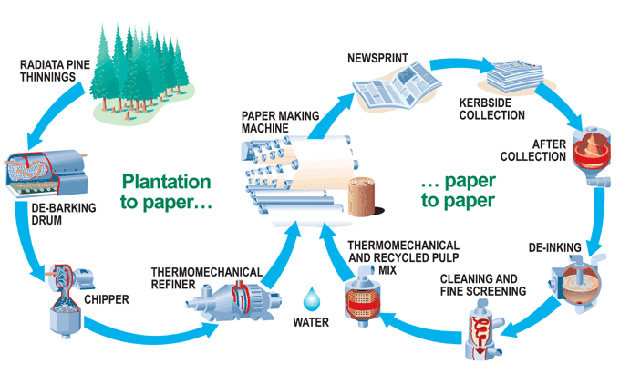Process of pulp and papermaking
In general, papermaking requires four sections, each with a different process. The main sections are as follows:
Pulping section: raw material selection→cooking and separating fiber→washing→bleaching→washing screening→concentration or copying into pulp sheet→storage reserve
Papermaking section: slurry → impurity removal → seminal pulp → beating → preparation of various additives → mixing of paper stock → flow of paper stock → head box → net part → press section → drying section → surface sizing → drying → pressing Light→rolling into paper
Coating section: coated base paper → coater coating → drying → coiling → rewinding → super calendering
Processing section: rewinding → cutting plate (or reel) → sorting packaging → end of storage
Modern papermaking procedures can be divided into main steps of pulping, preparation, papermaking, processing, etc.

Pulping process
Pulping is the first step in papermaking. Generally, the method of converting wood into pulp is mechanical pulping, chemical pulping and semi-chemical pulping.
Modulation process
The modulation of paper stock is another important point of papermaking. The strength, color tone and printability of the paper after completion, and the length of paper storage period are directly related to it. The general common modulation process can be roughly divided into the following three steps:
a.Flake cellulose
b. Beating
c. Adding glue and filling

The process of papermaking
- The main work of the papermaking department is to make the thin paper materials evenly interlaced and dehydrated, and then dried, calendered, rolled, cut, sorted and packaged. Therefore, the common processes are as follows:
- Screening of the stock material The prepared paper stock is further diluted to a lower concentration, and the screening material is used to screen the debris and the undissociated fiber bundle again to maintain the quality and protect the equipment.
- Net section The paper material flows out of the head box on a circulating copper wire mesh or plastic mesh and is evenly distributed and interwoven.
- The press section guides the wet paper with the net surface removed to a two-tray with a felt, and the wet paper is further dehydrated by the pressing of the rolling and the water absorption of the felt, and the paper is more dehydrated. Tight to improve the paper and increase the strength.
- Calendering Due to the wet paper after pressing, the water content is still as high as 52-70%. At this time, it is no longer possible to use mechanical force to remove moisture. Therefore, the wet paper is passed through a number of cylinders that pass through the hot steam. The surface makes the paper dry.
- Roll paper Due to the wet paper after pressing, the water content is still as high as 52-70%. At this time, it is no longer possible to use mechanical force to remove water. Therefore, the wet paper is passed through a number of cylinders that pass through the hot steam. The surface makes the paper dry.
- Cutting and sorting packaging: take a number of paper rolls that have been rolled into a tube in front, cut them into sheets of paper with a paper cutter, and then manually or mechanically sort out the paper with damaged or stained paper. Finally, pack every five hundred packs into one pack.

